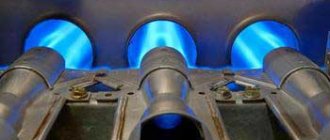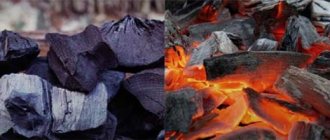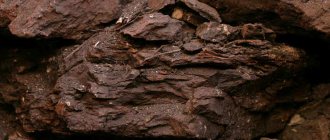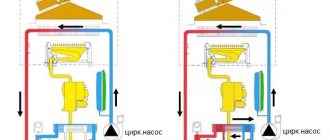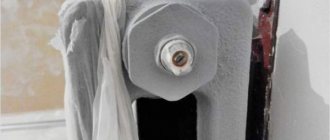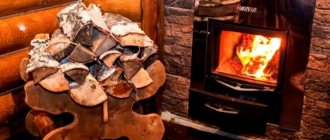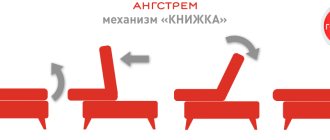Types of boilers and burners
Boilers with automatic fuel supply operate on coal or biomass (pellets, oat grains, sunflower husks, wood chips, etc.). Among coal boilers, the most popular boilers are those using “eco-pea” coal as fuel (coal granules with a diameter of 5-25 mm).
To burn fuel in boilers, burners are used: retort, tray or flare. 85% of installed coal boilers with automatic feed operate on retort or tray burners - we will consider these solutions.
Advantages and disadvantages of coal boilers
Reviews for automatic coal boilers are positive, as are reviews for wood boilers. Users note the advantages of two types of fuel. In recent years, biofuel has also become popular - briquettes made from various organic wastes, for example, shavings, sawdust, etc.
Its price is lower, although the fuel cannot boast of such efficiency as stone or brown coal. Automatic long-burning coal boilers are considered more energy efficient, but they also have a number of disadvantages:
- For example, they require a constant supply of electricity to function. The fan depends on the home network, and if there are interruptions, the boiler will also not work. For suburban areas where periodic power outages may occur, this fact is very important and must be taken into account.
- The market price for such a unit is quite high. Some people may find it easier and cheaper to buy a classic wood-burning device, and delivery of logs may not be difficult. But making the right choice of firewood is also often not easy; they will also need to be provided with optimal storage conditions.
- Although the two fuels are considered environmentally friendly, burning coal has a higher risk of producing carbon monoxide. Therefore, heating equipment must be installed in a separate boiler room, located away from living rooms.
A limited amount of oxygen during combustion leads to the formation of toxic substances, because of this it is not recommended to stay in the boiler room for a long time.
Firewood burns faster, and the risk of burning with such fuel is lower. In addition, coal dust stains all objects in the room.
At the same time, logs cannot heat as effectively. To maintain the optimal temperature, more fuel is needed, resulting in higher costs.
Using coal to heat your home is a very profitable option that is becoming increasingly popular. Most European residents want to quickly switch to safe heating, and regular coal is perfect for this.
Currently, the market is replete with offers for the purchase of coal boilers for heating; manufacturers guarantee efficient fuel consumption and high-quality heat supply to housing, in addition, they are constantly improving their equipment to achieve greater energy efficiency. You can consider coal boilers from such popular manufacturers as Bosch, Atmos, Proterm, Buderus, Ferroli, Wissman, Lemax, etc.
The problem of organizing automatic supply of solid fuel has always worried the developers of solid fuel boilers. If in the case of firewood it is quite problematic to organize it, then when using coal and pellets the situation looks more realistic. Today in our review we will look at the most popular automatic coal boilers, and how they implement a mechanism for delivering fuel to the combustion zone.
Automatic feeding of pellets is most often done using a soft or hard auger. Coal can be delivered to the furnace using a screw conveyor only if its fractions are sufficiently small in size and homogeneous, but most often this is not the case. Today we will look at several coal boilers, in which the mechanism for automatically supplying fuel from the bunker to the combustion chamber is implemented in different ways.
Retort burners
Retort burners consist of a cast iron elbow (retort) and a cast iron grate burner in which the fuel burns. Some burners are equipped with a "ring gear" whose rotation stirs the fuel, breaks down the coking slag, and distributes the fuel throughout the retort tray.
Thanks to the 90-degree bend, the burner is installed in the middle of the combustion chamber, so the side walls of the boiler are heated evenly and do not overheat. The design increases the path to the fuel hopper and reduces the likelihood of fuel fire in the feeder.
Another advantage is low sensitivity to deposits arising in the hearth itself: incoming portions of fresh fuel automatically dump unburnt or sintered fuel into the boiler ash pan.
There is also a downside - bending the knee complicates the supply and combustion of fuel, which eventually settles at the bend. Sediment and carbon deposits build up, reducing the "throat" for fuel movement on its way to the top of the burner. This results in increased resistance of the auger feeder, premature wear of the auger and breakage of the pin (shear bolt) protecting the auger feeder.
Tray burners
Tray burners are a tray made of steel or cast iron into which an auger supplies fuel.
The main advantage of tray burners is their omnivorous nature. The burner burns most types of fuel and fuel mixtures available on the market. Fuel is supplied to the hearth only in a horizontal direction and over a shorter distance compared to a retort burner. The resistance of the feeder during operation of the auger in this case is minimal. At the same time, the short distance of fuel movement and horizontal supply increase the likelihood of fuel backfiring towards the fuel bunker. Therefore, for such structures, additional protection against backfire (fire extinguishing group) is organized.
Another disadvantage is the sensitivity to the formation of sintered substances and deposits in the burner. Deposits accumulate at the end of the burner tray and are more difficult to remove automatically - they will only be removed when the next portion of fuel is fed into the burner.
Solid fuel boilers with automatic fuel supply
When choosing automatic solid fuel boilers, you should initially pay attention to the following types:
- combined units that have several fireboxes or burners, which allows simultaneous operation in different modes;
- pyrolysis equipment that can boast the highest energy efficiency indicators;
- pellet boilers that can easily operate without constant supervision for up to one week (7 days).
You can buy an automatic long-burning solid fuel boiler in Moscow and St. Petersburg not only in the online store, but also in our retail outlets in these cities. Their address and telephone numbers are available on the website.
Why is it worth buying automatic solid fuel boilers for heating a country house or cottage? Initially, it is worth remembering the following advantages:
- the versatility of such units, capable of using different types of fuel;
- the ability to manually load fuel in case of power failures;
- simple and intuitive control panel;
- inexpensive service;
- durability of use.
According to reviews from owners who purchased this heating equipment, their heating costs have significantly decreased. This is due not only to the relative cheapness of solid fuel, but also to the economical operation of modern boilers with automatic supply of sawdust, pellets, wood chips or other fuel options.
Reverse heat flow to the bunker (fire)
A rare but familiar accident to manufacturers is the reverse flow of heat to the bunker. In 9 cases out of 10, the situation arises due to the negligence of the boiler user himself. Also, a reverse flow of heat occurs when the safety pin breaks, after which the auger stops rotating.
If the bunker is tightly closed, the fan is running, and nothing prevents the movement of flue gases from the boiler into the chimney, even if the auger does not rotate, there is nothing to fear.
Reverse heat flow (fire) is a rare phenomenon in boilers with automatic fuel supply. However, boiler manufacturers equip supply systems with two safety stages to eliminate such a possibility in principle.
The first stage is a temperature sensor, installed on the fuel supply pipe: if the temperature exceeds the set one, the sensor signals the boiler controller to solve the problem. The controller begins to continuously circulate fuel through the pipe until the sensor temperature returns to normal. The continuous supply interval in Galmet boilers is 10 minutes.
If the problem remains, the thermostatic valve is activated - water is supplied from the emergency tank into the pipe and eliminates the fire in the feeder pipe.
One of the causes of fuel fire in the tank is backdraft, which occurs if the bunker is left open or closed incorrectly. To prevent this from happening, some manufacturers equip the fuel tank lid with a limit switch. When the hopper lid is not closed tightly, the sensor is triggered and gives a warning signal. If measures are not taken, the controller will stop the boiler.
Operating principle of automatic coal boilers
It is important to understand the structure and operating principle of modern automated boilers even without interest, because this knowledge will help you decide on the model. In order for a coal boiler and the heating and hot water system based on it to be able to operate autonomously, safely and cost-effectively for a long time, the following processes must be automated:
- loading portions of coal or other fuel;
- removal of ash from the combustion zone into the storage tank;
- the air supply from the boost fan to the burner must be regulated;
- the temperature in different rooms corresponded to the set temperature;
- the heated floor is heated as specified;
- hot water is available at all service points;
- Circulation pumps and mixing valves correctly direct the coolant and warm water.
The user's function is to select the operating mode (setting priority or schedule), or the coolant temperature, or the temperature in each room. Dynamic processes depending on weather changes, water consumption, quantity and quality of fuel, and air intake are monitored and interpreted by the processor. A full set of options for an automatic coal boiler is expensive, so often only the most labor-intensive processes are automated: loading fuel and air pressurization.
Organization of automatic feeding using a screw, the most typical device for modern models.
The principle of operation of the boiler itself has not changed: oxygen enters the burning coal through the blower, maintaining combustion, and exhaust gases go into the chimney. Thermal energy heats up the coolant located in the container around the burning coal, and the carrier goes through the pipes to the radiators. Having given off heat, the liquid returns to the boiler for heating.
There are two options for burning coal:
- Classic . Coal burns, and pyrolysis gases escape into the atmosphere.
- Pyrolysis . The exhaust gases are saturated with oxygen and burned, thereby increasing the efficiency of the boiler and increasing the burning time of one portion of coal at least twice, but the cost of pyrolysis models is also at least twice as high.
Structurally, the boiler is also traditional. With classic coal combustion, there is one firebox, the coal burns on grates, air is supplied from below naturally, its level is regulated by the ash door, and the exhaust gases are regulated by the chimney damper. The boiler body, also known as the coolant container, is surrounded by burning coal. In the pyrolysis version, a forced air supply system is placed above the classic firebox for afterburning gases and solid particles in them, so a well-functioning boiler does not smoke.
There are many implementations of coal-fired boilers with different levels of automation on the market.
Fuel supply system
The most labor-intensive and rather dirty task when operating coal-fired boilers with automatic feeding is loading fuel into it. By automating this process, you can ensure that the bunker is filled no more than once a week. If the budget allows you to automate the supply of coal to the boiler bunker from a seasonal warehouse, this will make life in the house comfortable throughout the heating period.
An example of organizing automatic feeding into a bunker from an external warehouse when the boiler room is located in the basement. However, such systems are not sold in ready-made or even modular form.
In coal-fired boilers, two types of automatic coal supply system designs were obtained: screw and drum type.
A hopper with coal for loading a pyrolysis (and often a classic) boiler is installed on the side of the boiler. At the bottom, the box is equipped with a screw, which is rotated by an electric motor at the command of the computer when operating in automatic mode or from a button in manual mode. The duration of engine operation is set by the computer, thereby determining the portions of coal loaded into the boiler. At the same time, the boost is turned on to control the combustion process.
A boiler with such automation maintains high efficiency when the rated power fluctuates from 30% to 100%, filling the hopper up to once a week, effectively responding to weather changes and user settings. Filling the bunker with high quality coal (fraction from 5 mm to 25 mm), depending on the model, is necessary once a week.
In classical combustion boilers, a bunker with coal is often placed above the boiler and automatic loading occurs using a drum (rotating grate). It, rotating around its own axis, supplies a portion of solid fuel to the firebox. After burning, the slag and ash fall into the storage tank. In this case, the fuel requirements are lower, and there are many specific design solutions for automating such boilers.
Ash removal
The second unpleasant procedure after loading coal into the bunker is removing slag, caked crust and cleaning the ash storage tank. If the boiler is not connected by a conveyor to a seasonal fuel storage, it is advisable that both procedures occur with the same cycle - once a week. Self-cleaning models still require attention, but every 4-6 weeks.
The system for automated ash removal into an external box is quite simple, but organizing it is neither easy nor cheap, so it is very rare in coal models.
The amount of ash in the storage tank is directly affected by the quality of coal, such as ash content. Direct combustion boilers are not too demanding on the quality of fuel and can even be heated with household waste. But ash removal will have to be done more often, and the declared characteristics can be obtained on coal with a moisture content below 30% and an ash content of less than 25%.
Pyrolysis boilers, in addition to low humidity up to 20% and ash content less than 15%, also require a certain size of coal fractions from 5 mm to 25 mm. Deviation from these requirements reduces the performance of the unit and increases the amount of ash. Part of the unburnt coal can be reused after sifting the ash from the storage tank
Automatic ignition of boilers using liquids, manual removal of ash from their storage tank and self-cleaning of burners can be offered as additional options for very expensive boiler designs and are quite rare. Unlike pellet models, you shouldn’t count on a self-cleaning system in coal models.
What to do to avoid fire?
- Ensure constant boiler draft, hermetically seal the fuel tank and monitor the condition of the fuel tank lid gasket.
- Check the cleanliness of the channel and the air mixer chamber: dust or ash enters the mixing chamber through the blowing nozzles and over time clogs the air supply channel of the fan - as a result, the fuel burns unevenly and the efficiency of the boiler decreases.
- Adjust the fuel supply parameters; if the supply speed is slower than necessary and the air supply to the burner is incorrectly configured, more intense fuel combustion occurs. The result is that combustion begins to move down the burner and goes into the fuel supply pipe.
- The burner metal also heats up and heats the feed tube, resulting in a false alarm indicating reverse heat flow. To avoid false alarms, install a special non-flammable gasket separating the burner and the pipe - the gasket will not allow the temperature of the heated burner to be transferred to the feeder pipe.
Smoke from the fuel tank.
There is a simple “at-home” way to check the quality of smoke removal from the boiler: open the boiler door - if adjusted correctly, smoke does not come out, even if all doors are open.
If exhaust gases (smoke) come out of the fuel tank, this is a sign of insufficient chimney draft. This happens when the boiler chimney or the incoming combustion air mixer is clogged. The second reason is incorrect boiler control settings or a simply unsuccessful boiler design.
Another note: when adding fuel to the firebox, make sure that the burner is at rest (the fan is turned off and does not create excess pressure in the boiler).
Broken pin (shear bolt): causes.
A common reason for the boiler to stop working is the pin (shear bolt) that connects the engine to the auger breaks. Below are possible reasons for this failure:
- Fuel of non-recommended fraction
- Foreign bodies in fuel (bolt, stone, pieces of wire)
- Deposits (carbon deposits) in a retort-type burner - carbon deposits reduce the diameter of the channel for fuel supply to the burner and increase the resistance of the screw. The problem is easily identified: when carbon deposits are deposited on the retort elbow, the “crunching” sound when fuel is supplied to the burner becomes louder. Once a year, before the start of the heating season, clean the fuel supply elbow to the burner. If the boiler runs on pellets, it is better to repeat the procedure during the season - when using pellets, carbon deposits form faster.
- Damage to the auger. Over time, the auger turns wear out mechanically or are destroyed by sulfur contained in the fuel. In places of wear, the auger does not move fuel but grinds it. Sawdust or coal chips accumulate in the feed tube, increasing the resistance of the auger. The wear rate of the auger depends on the humidity of the fuel used, the sulfur content in the fuel and the location of the boiler room (in a damp basement and without ventilation, the service life of the equipment is reduced).
- Incorrect installation of the boiler (the adjustable foot of the fuel tank is used to adjust the height and leveling of the boiler supply system).
| IMPORTANT! When transporting the boiler, do not lift the structure by the screw feeder pipe: if the load is distributed incorrectly, the pipe is deformed and the geometry of the feed system is disrupted. The result: additional noise when the auger rotates, its premature wear and constant pin failures. |
How to choose an automatic coal-fired boiler
Economical small home automatic coal boilers, with an efficiency of up to 90%, are recommended by a couple of dozen manufacturers. The models are distinguished by their performance, specific design and the presence of a hydraulic circuit for hot water supply.
The selection of a heating boiler is made based on the following thermal parameters:
- Degree of automation – modern bunker coal heating units, equipped with a microprocessor controller. If the client wishes, the heating equipment is equipped with a self-cleaning and remote control system. After the GSM module has been installed, the operation of the boiler is controlled using any mobile device. The new generation controller is capable of automatically supporting the operation of several heating circuits: radiator heating and “warm” floors.
- Fuel storage capacity - in most cases, the bunker is designed to ensure independent operation of the boiler for 3-7 days.
- Productivity - calculation is performed according to the formula 1 kW = 10 m?.
Particular attention is paid to the requirements for the automation of a remote control system for boiler operation. The remote control unit must connect to the Internet, have a stable radio signal and operate stably even with interference in the electrical network.
Additionally, the degree of insulation of the device is taken into account. When using coal in a boiler plant, there is a high probability of accumulation of combustible dust. Due to this, the control unit must have a protection degree of at least IP 26.
Famous Coal Bunker Boiler Manufacturers
In addition to choosing an installation based on technical specifications, choose a boiler based on the manufacturer. The consumer is offered equipment of various price segments.
Domestic-made boilers remain the most inexpensive. At the same time, the models have good build quality, reliability and a long service life.
European boilers are offered in the premium class. The models are distinguished by their high automation and practicality.
The more common ones are:
- German boilers – Roda, Buderus.
- Czech boilers – Metal-Fach.
- Turkish models – Termodinamik, Emtas.
- Polish boilers – Stalmark, Defro.
Nowadays, Russian boilers are quite in demand. The reason is the regularly improving product quality and reduced price when compared with foreign units. The main disadvantage is considered to be small flaws in the combustion process automation system.
It is necessary to pay attention to boilers ALTEP, TIS EKO, KAZ Kordi, etc.
Asian boilers operating on solid fuel are demonstrated in a small range of products. Attention is paid to Kentatsu models, which stand out for their operational capabilities, but are inferior in thermal properties and reliability to Russian and analogues from European countries.
Cost of automatic boilers on coal
Coal heating devices with automatic fuel supply are produced with a low operating capacity of 15 kW. Models from a Russian manufacturer, with a built-in bunker, cost approximately 160 thousand rubles.
European analogues are much more expensive, approximately several times. Boilers manufactured by Buderus and Roda cost 350-500 thousand rubles. Connecting heating equipment costs approximately 5-10% of the cost of the station.
Opinions about coal-fired boilers with automatic fuel supply
The initially wary opinion of consumers regarding automated coal equipment was gradually replaced by a high number of enthusiastic reviews on the Internet.
Despite the many good aspects: a long time of independent operation, a high degree of safety, economy and reliability, boilers have several real disadvantages:
- Dependence on electrical energy - operating a boiler without electricity is not possible. After turning off the voltage, the screw transmission, the system of forced injection and removal of combustion products stops. To ensure the operability of the boiler, the connection to the electrical network is made through a UPS and a stabilizer.
- Dust deposits - burning a coal combustion chamber has one serious drawback. During the combustion and fuel supply process, a considerable amount of very small dust accumulates. Under a number of circumstances, very small particles, having reached a specific concentration, can cause an explosion. Dust control when loading a bunker with coal includes the installation of specialized dust collectors. Constant wet cleaning will also be required.
Despite two significant disadvantages, coal-fired automated boilers are especially favored by our consumers, as evidenced by the constant demand for heating equipment of this type.
Electronics defects
In the boiler room, in addition to the boiler itself, auxiliary equipment is installed that controls the operation of the system: circulation pumps and hot water pumps, valves and distribution manifolds, safety group electronics. Random errors in the operation of equipment lead to malfunctions of the boiler controller. Factory malfunctions of the equipment are also possible - the manufacturer accepts it as acceptable if for every 1000 products 30-50 controllers work with errors after launch.
When connecting devices, surprises also happen: a short circuit of the triac - transistor of the fuel supply system or fan motor causes continuous operation of the feeder (auger) or fan. If the fan or auger is constantly running, the boiler controller generates an error signal and turns off.
Even if connected incorrectly, it is possible to damage the connector that connects the pump power to the controller. This is unpleasant, but not fatal: in this case, the pump is connected directly to the outlet.
Sometimes a boiler is purchased in advance, and then it waits in the boiler room for installation. The boiler is tightly closed with a bag or film: when temperature changes, condensation forms, including on the controller elements, which then fail. If you purchase the boiler in advance, prepare a suitable storage place - dry and warm with free access of air to the controller.
Aging of boiler elements
Check your boiler periodically to ensure safe and trouble-free operation in the upcoming heating season. In boilers with a screw mechanism, the feeder is damaged within 2 years: it is worn out or corroded due to exposure to sulfur and moisture. If the boiler runs on low-sulfur fuel (pellets or oat grains), the corrosion process will be minimal. But when coal is burned, the moisture in the fuel accelerates corrosion of the auger.
By carefully lubricating the connections and rubbing elements of the fuel supply device, it is possible to increase the service life of the feeder up to 10 years. And if you need to remove the auger from the feeder for maintenance or repair, this will be easier to do.
And it’s not only easier, but also safer; without lubrication, the auger “sours.” To dismantle it, you will have to knock the auger out of the mounting hole, risking damage to the gearbox, which costs much more.
Clean the heat exchanger thoroughly after the end of the heating season. During the period when the boiler is not in operation, the boiler heat exchanger must be constantly ventilated: to do this, open the boiler doors and check the flow of fresh air into the boiler room.
The connection between the boiler and the chimney also corrodes and leads to leakage of combustion products (flue gases), reducing the efficiency of the boiler. To avoid leakage of flue gases from the boiler, monitor the quality of the sealing gaskets at the joints.
Once every 2-3 years, replace the fuel supply motor and fan. If this is not possible, disassemble and clean the blades of the fan impeller: dirty blades reduce the quality of the fan, reduce the capacitance of the condenser and cause axial runout of the rotor, which eventually disables the fan.
The working process
So, the process of heat supply using an automatic boiler and coal as fuel consists of several stages:
- coal is poured into the bunker manually. The number of bookmarks and the time of continuous operation of the system depend on the capacity of the bunker;
- The auger feeds fuel into the chamber automatically. The gearbox does not stop working from the electric motor;
- fuel is squeezed into the chamber and air is supplied under pressure;
- combustion occurs in thin layers, reducing the amount of soot and unburned particles, but if necessary, the boiler will automatically remove ash.
